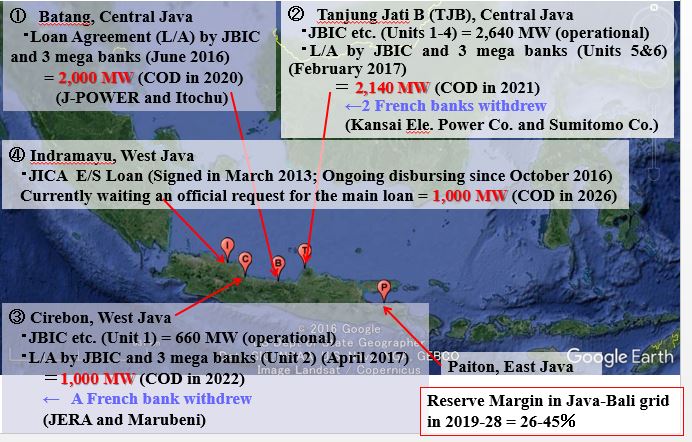Coal-fired Power Plant Projects in Indonesia
Status of Power Development in Indonesia
Indonesia has the largest population (265.02 million as of 2018) and the biggest highest energy demand of any country in Southeast Asia.
According to data from the Indonesia State Electricity Company (PLN), installed power generation capacity was 56,509.53 MW in Indonesia as of October 2018. Coal-fired power plants accounted for 47% of this amount (Table 1) (Net installed capacity was 51,185.88 MW; coal plants accounted for 48%). [1]
| Year | Unit | Coal | Gas | Oil | Hydraulic(including small scale) | Geothermal | Biomass | Solar | Other Renewables | 合計 |
|---|---|---|---|---|---|---|---|---|---|---|
| 2018 | MW | 26,410.70 | 16,424.41 | 6,657.67 | 4,938.64 | 1,814.30 | 167.54 | 25.19 | 71.07 | 56,509.52 |
| % | 46.74 | 29.06 | 11.78 | 8.74 | 3.21 | 0.30 | 0.04 | 0.13 | 100 |
The current president of Indonesia, Joko Widodo, has advanced a program to develop 35 GW of power plant capacity in the period from 2015 to 2019. According to the Director General for Electricity of the Ministry of Energy and Mineral Resources (ESDM), as of year-end 2018 only 2,899 MW (8%) of the 35 GW program has begun commercial operation, and the program is now expected to be completed in 2024. [2] In the 35 GW program, coal power plants account for 52.3% (18,739 MW), the largest of any source. [3]
In its Electricity Supply Business Plan (RUPTL) 2019-2028, PLN projects an electricity demand growth rate of 6.42% per year, with a total generation capacity development of 56,395 MW planned during this 10-year period. The composition (%) of planned development by type of power plant is shown below. Coal is the largest.
- Coal 27,063 MW (48%; including mine mouth type 5,690 MW)
- Gas 12,416 MW (22%)
- Geothermal 4,607 MW (8%)
- Hydro (including mini and micro) 9,543 MW (17%)
- Oil 201 MW (0.4%)
- Renewables 2,564 MW (5%)
With this development, the composition of power sources in 2028 will be 54.4% coal, 23.2% renewables, 22.0% gas, and 0.4% oil. [1] In other words, Indonesia’s high reliance on domestic coal as a power source will remain unchanged. (Note: The RUPTL figure for renewables includes large hydropower, which should be excluded from renewables.)
Status of Power Development for the Java-Bali Grid
Of the total generation capacity planned for development (56,395 MW) in RUPTL (2019-2028), around 46%, or 25,902 MW, is planned inwill be added to the Javwa-Bali grid. And the development of nNew coal power plants accounts for around 54% of this amount (14,046 MW).
An excess of electricity supply, however, has been recently pointed out, given that the reserve margin of the Java-Bali grid is around 30%. The actual figures in 2018 were 34,519 MW net installed capacity and 27,070 MW net peak demand; that is, a reserve margin of 28%. [1]
In addition, the reserve margin of the Java-Bali grid in the 2019-2028 period comes to 26-45% when we calculate it based on RUPTL (2019-2028). In other words, excess electricity supply will remained as an issue for the Java-Bali grid.
| Year | 2019 | 2020 | 2021 | 2022 | 2023 | 2024 | 2025 | 2026 | 2027 | 2028 |
|---|---|---|---|---|---|---|---|---|---|---|
| Net demand peak(MW) | 28,291 | 29,852 | 31,541 | 33,397 | 35,236 | 37,086 | 38,981 | 40,951 | 43,194 | 45,661 |
| Net installed capacity(MW) | 35,748 | 42,126 | 43,585 | 46,487 | 49,559 | 52,910 | 56,494 | 57,494 | 58,154 | 59,154 |
| Supply reserve rate (%) | 26.4 | 41.1 | 38.2 | 39.2 | 40.6 | 42.7 | 44.9 | 40.4 | 34.6 | 29.6 |
| Japan-supported coal-fired power plants scheduled to start operation | Lontar4, Batang | TJB 5, 6 | Cirebon 2 | Indramayu |
Japan-supported Coal Power Projects in the Java-Bali Grid
Of the 14,046 MW from new coal power plants planned for the Java-Bali grid, around 44%, or 6,139 MW (five projects), [1] are being pursued with support from Japanese public agencies, such as the Japan Bank for International Cooperation (JBIC), Nippon Export and Investment Insurance (NEXI), and Japan International Cooperation Agency (JICA). (Figure 1)
As indicated in Table 2, the Lontar 4 plant began commercial operation in 2019, Batang is slated to start in 2020, Tanjung Jati B (Units 5 and 6) in 2021, Cirebon 2 in 2022, and Indramayu 2 in 2026. Considering the Java-Bali grid’s reserve margin, however, the necessity of all of these projects is in question. Besides, each project has drawn international criticism from the viewpoint of climate change, and some projects, such as Batang, Cirebon 2, and Indramayu 2, have been delayed due to strong opposition by local communities who are concerned about the adverse impacts on their livelihoods (including farming and fishing) and health.
Figure 1. Four Japan-supported new coal-fired power plant projects on the the Java-Bali grid(6,140 MW*)**
- * The capacity of each of the 4 projects in this figure is the value described in the environmental assessment document for each project.
- ** This figure does not indicate Lontar Unit 4 (315 MW; Sumitomo Corporation has an EPC contract and export finance is supported by JBIC).
Reference
- [1] The Electricity Supply Business Plan (RUPTL) for the period of 2019-2028 (Indonesia State Electricity Company (PLN); February 2019). FoE Japan created Table 1 based on RUPTL data.
- [2]https://www.rambuenergy.com/2019/01/indonesia-govt-now-expects-35-gw-project-fully-completed-in-2024/
- [3] Survey on Progress of Long-term Electricity Program and Coal Export Trends in Indonesia (Japan Oil, Gas and Metals National Corporation (JOGMEC); March 2018)



